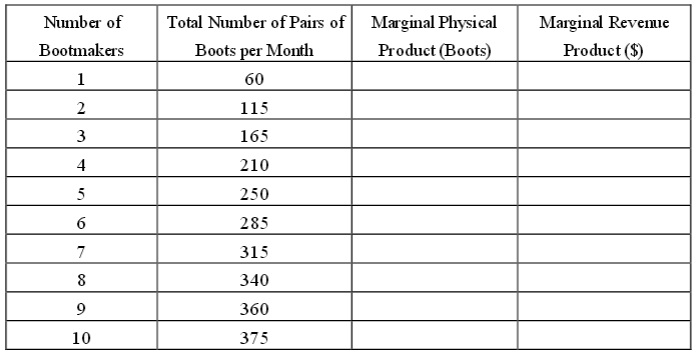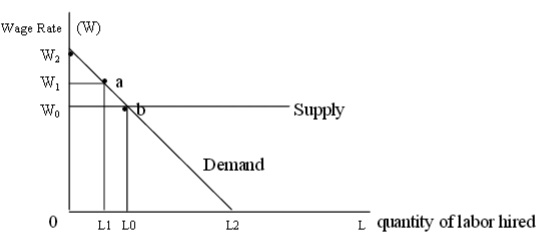Problem 1. Tony runs a small company, Bearpaw Boots, that manufactures hiking boots. Table shows output per month for different quantities of labor.
a. Fill in the third column by using the data in the second column to compute the marginal physical product of each additional worker.
b. Tony can sell boots for $60 a pair. As Tony has a small firm, the price of boots is unaffected by the quantity that he sells. Fill in the fourth column by computing the marginal revenue products of each worker.
c. Assume Tony sells his product in a perfectly competitive market and hires in a perfectly competitive labor market. How many workers will Tony employ if monthly wages are $1800?
d. What will be Tony’s profits given his hiring decision in (c)?
Table:

Problem 2. Fill in the following blanks. In a competitive labor market, ____(1)_____ and____(2)___ will be determined by the interaction of the demand and the supply of labor curves. The supply of labor comes from individual decisions to work. Individual decisions to supply work are simultaneously decisions to forgo leisure. Thus, a decision to supply less labor is simultaneously a decision to demand more ___(3)___. At higher wages, the same number o f working hours will mean a larger income. If leisure is not an inferior good, people are apt to demand ___(4)___(more/less) leisure as their income increases. This suggests that the supply of labor might ___(5)___ (increase/decrease) as wages increase. This is called __(6)___(income/substitution) effect of higher wages.
Higher wages also increase the opportunity cost of an hour of leisure. As a result we expect that as wages increase, the substitution effect will lead people to work ___(7)___(more/less) . The ultimate effect of increased wages comes from the sum of the income and substitution effects. Statistical evidence suggests that at low wages the __(8)____ effect predominates and labor supply __(9)___ with an increase in wages, while at high wages the two effects tend to __(10)___(enhance/offset) each other.
In some cases , the market determination of wages and employment is affected by a legal floor on wages rates, or a ___(11)____rate. To be effective, the minimum wage must be ___(12)____ (higher/low er) than the market wage. Imposing a minimum wage will ___(13)__(increase/decrease) the volume of employment as firms move upward and to the left along their demand curves for labor. At the same time the promise of higher wages is apt to increase the ___(14)__ (demand/supply) of labor. Minimum wage laws affect primarily __(15)__(skilled/unskilled) labor markets. A major noncompetitive feature in many skilled labor markets is the existence of labor ____(16)____.
Problem 3. Suppose that the marginal revenue product sc hedule or demand for labor for one of 100 identical and perfectly competitive firms is given by column (1) and (2) of table, and the market supply schedule of labor is given by columns (1) and (3).
a. Find the market demand schedule for labor and the equilibrium wage rate.
b. How much labor should the firm hire to maximize its total profits?
c. Graph the results to part (a) and (b).

Problem 4. The following figure illustrates the short run labor supply and demand curves for a competitive firm. Use the information to answer the following true/false questions.

a. The firm immediately encounters diminishing marginal returns upon hiring the first units of labor.
b. The firm hires labor in a perfectly competitive labor market.
c. The firm can influence the price of labor.
d. The firm will hire L0 units of labor per time period.
e. Labor receives an amount of income equal to the area of rectangle 0W0 bL0.